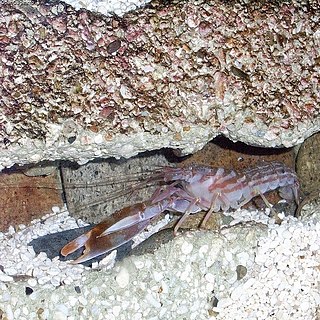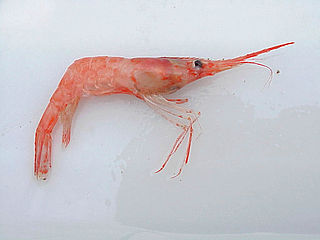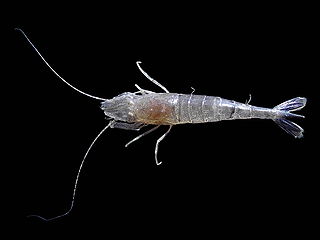
Caridina is a genus of freshwater atyid shrimp. They are widely found in tropical or subtropical water in Asia, Oceania and Africa. They are filter-feeders and omnivorous scavengers. They range from 0.9–9.8 mm to 1.2–7.4 mm in carapace length.

Hippolytidae is a family of cleaner shrimp, also known as broken-back shrimp or anemone shrimp. The term "broken-back shrimp" also applies to the genus Hippolyte in particular and "cleaner shrimp" is sometimes applied exclusively to Lysmata amboinensis.

Alpheus is a genus of snapping shrimp of the family Alpheidae. This genus contains in excess of 330 species, making this the most species-rich genus of shrimp. Like other snapping shrimp, the claws of Alpheus are asymmetrical, with one of the claws enlarged for making a popping noise. Some species in the genus enter into symbiotic relationships with gobiid fishes, and others associate with sea anemones.

Alpheopsis is a genus of shrimp of the family Alpheidae. Several species of the genus have been known to share the same burrows with members of different species. They are inhabitants of the eastern Pacific Ocean.

Petrolisthes is a genus of marine porcelain crabs, containing these extant species:

Palaemonidae is a family of shrimp in the order Decapoda. Many species are carnivores that eat small invertebrates, and can be found in any aquatic habitat except the deep sea. One significant genus is Macrobrachium, which contains commercially fished species. Others inhabit coral reefs, where they associate with certain invertebrates, such as sponges, cnidarians, mollusks, and echinoderms, as cleaner shrimps, parasites, or commensals. They generally feed on detritus, though some are carnivores and hunt tiny animals.

Palaemon is a genus of caridean shrimp in the family Palaemonidae.

Liocarcinus marmoreus, sometimes known as the marbled swimming crab, is a species of crab found in the northern Atlantic Ocean and North Sea. It may be found on sand and gravel in the sublittoral and lower littoral zones, down to a depth of 84 metres (276 ft), from the Azores and the Alboran Sea as far north as the Shetland Islands. It reaches a carapace length of 35 millimetres (1.4 in), and is distinguished from other similar species by the presence of three similarly sized teeth on the edge of the carapace, between the eyes, and by the marbled colouration on the carapace. L. marmoreus is sometimes parasitised by the barnacle Sacculina.
Raymond Brendan Manning was an American carcinologist, specialising in alpha taxonomy and mantis shrimp.

Inachidae is a family of crabs, containing 39 genera:

Lysmata is a genus of shrimp in the infraorder Caridea, the caridean shrimp. The genus belongs to the family Lysmatidae. Lysmata are popular ornamental shrimp in the marine aquarium trade for their bright color patterns, interesting behaviors, and ability to control certain aquarium pests such as sea anemones of the genus Aiptasia. They are known to command high prices on the pet market.

Pandalus is a genus of shrimp in the family Pandalidae. Members of the genus are medium-sized and live on or near the seabed. Some species are the subject of commercial fisheries and are caught by trawling. One species, Pandalus montagui, lives in association with the reef-building polychaete worm, Sabellaria spinulosa.

Crangon is a genus of shrimp.

Trachysalambria is a genus of prawns, containing ten species. It was erected in 1934 by Martin Burkenroad, as a subgenus of Trachypenaeus, with T. curvirostris as its type species. That subgenus was elevated to the rank of genus in 1997 by Isabel Pérez Farfante and Brian Kensley. The ten species are:

The crinoid shrimp, or feather star shrimpHippolyte catagrapha, is a species of shrimp in the family Hippolytidae
Leptochela is a genus of small shrimp from the family Pasiphaeidae. They are found in the Indo-Pacific region and the western Atlantic with an isolated species in Hawaii, they are absent from the eastern Atlantic Ocean and were absent from the eastern Pacific but specimens of a species widespread in the western Atlantic were collected from waters to the south of the tip of Baja California. Two species, Leptochela aculeocaudata and Leptochela pugnax have invaded the eastern Mediterranean from the Red Sea through the Suez Canal and are thus classified as Lessepsian migrants.

Periclimenes, commonly known as glass shrimp or cleaner shrimp, is a commensal and often symbiotic genus of semi-transparent shrimp within the family Palaemonidae. Species of this large genus feature a wide variety of coloration and patterns, widespread distribution throughout much of the world's tropical oceans, and are often sought out for aquarium trade.














